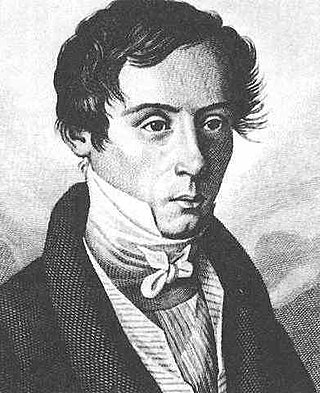
Augustin-Jean Fresnel was a French civil engineer and physicist whose research in optics led to the almost unanimous acceptance of the wave theory of light, excluding any remnant of Newton's corpuscular theory, from the late 1830s until the end of the 19th century. He is perhaps better known for inventing the catadioptric (reflective/refractive) Fresnel lens and for pioneering the use of "stepped" lenses to extend the visibility of lighthouses, saving countless lives at sea. The simpler dioptric stepped lens, first proposed by Count Buffon and independently reinvented by Fresnel, is used in screen magnifiers and in condenser lenses for overhead projectors.

Antoine-Laurent de Lavoisier, also Antoine Lavoisier after the French Revolution, was a French nobleman and chemist who was central to the 18th-century chemical revolution and who had a large influence on both the history of chemistry and the history of biology.

Diffraction is the interference or bending of waves around the corners of an obstacle or through an aperture into the region of geometrical shadow of the obstacle/aperture. The diffracting object or aperture effectively becomes a secondary source of the propagating wave. Italian scientist Francesco Maria Grimaldi coined the word diffraction and was the first to record accurate observations of the phenomenon in 1660.
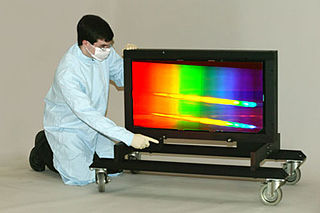
In optics, a diffraction grating is an optical component with a periodic structure that diffracts light into several beams travelling in different directions. The emerging coloration is a form of structural coloration. The directions or diffraction angles of these beams depend on the wave (light) incident angle to the diffraction grating, the spacing or distance between adjacent diffracting elements on the grating, and the wavelength of the incident light. The grating acts as a dispersive element. Because of this, diffraction gratings are commonly used in monochromators and spectrometers, but other applications are also possible such as optical encoders for high precision motion control and wavefront measurement.
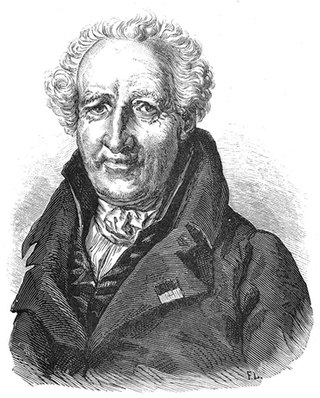
Antoine Laurent de Jussieu was a French botanist, notable as the first to publish a natural classification of flowering plants; much of his system remains in use today. His classification was based on an extended unpublished work by his uncle, the botanist Bernard de Jussieu.
The year 1818 in science and technology involved some significant events, listed below.

Louis Jacques Thénard was a French chemist.
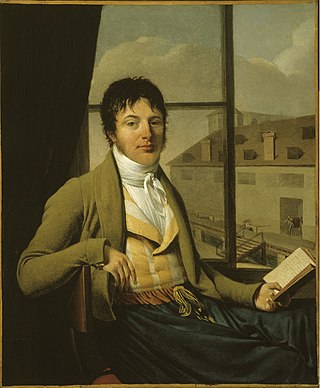
Jean-Antoine Chaptal, comte de Chanteloup was a French chemist, physician, agronomist, industrialist, statesman, educator and philanthropist. His multifaceted career unfolded during one of the most brilliant periods in French science. In chemistry it was the time of Antoine Lavoisier, Claude-Louis Berthollet, Louis Guyton de Morveau, Antoine-François Fourcroy and Joseph Gay-Lussac. Chaptal made his way into this elite company in Paris beginning in the 1780s, and established his credentials as a serious scientist most definitely with the publication of his first major scientific treatise, the Ėléments de chimie. His treatise brought the term "nitrogen" into the revolutionary new chemical nomenclature developed by Lavoisier. By 1795, at the newly established École Polytechnique in Paris, Chaptal shared the teaching of courses in pure and applied chemistry with Claude-Louis Berthollet, the doyen of the science. In 1798, Chaptal was elected a member of the prestigious Chemistry Section of the Institut de France. He became president of the section in 1802 soon after Napoleon appointed him Minister of Interior. Chaptal was a key figure in the early industrialization in France under Napoleon and during the Bourbon Restoration. He was a founder and first president in 1801 of the important Society for the Encouragement of National Industry and a key organizer of industrial expositions held in Paris in 1801 and subsequent years. He compiled a valuable study, De l'industrie française (1819), surveying the condition and needs of French industry in the early 1800s.

François Auguste Péron was a French naturalist and explorer.
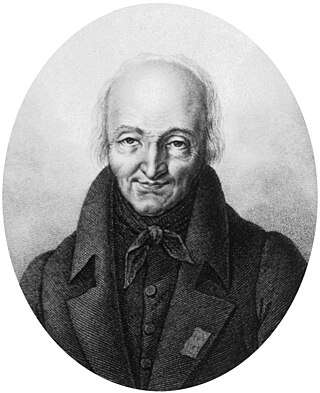
René Just Haüy FRS MWS FRSE was a French priest and mineralogist, commonly styled the Abbé Haüy after he was made an honorary canon of Notre Dame. Due to his innovative work on crystal structure and his four-volume Traité de Minéralogie (1801), he is often referred to as the "Father of Modern Crystallography". During the French revolution he also helped to establish the metric system.
Comptes rendus de l'Académie des Sciences, or simply Comptes rendus, is a French scientific journal that has been published since 1835. It is the proceedings of the French Academy of Sciences. It is currently split into seven sections, published on behalf of the Academy by Elsevier: Mathématique, Mécanique, Physique, Géoscience, Palévol, Chimie, and Biologies.
The Society of Arcueil was a circle of French scientists who met regularly on summer weekends between 1806 and 1822 at the country houses of Claude Louis Berthollet and Pierre Simon Laplace at Arcueil, then a village 3 miles south of Paris.

Pierre Jean Robiquet was a French chemist. He laid founding work in identifying amino acids, the fundamental building blocks of proteins. He did this through recognizing the first of them, asparagine, in 1806, in the industry's adoption of industrial dyes, with the identification of alizarin in 1826, and in the emergence of modern medications, through the identification of codeine in 1832, an opiate alkaloid substance of widespread use with analgesic and antidiarrheal properties.

Traité élémentaire de chimie is a textbook written by Antoine Lavoisier published in 1789 and translated into English by Robert Kerr in 1790 under the title Elements of Chemistry in a New Systematic Order containing All the Modern Discoveries. It is considered to be the first modern chemical textbook.
Armand Jean François Séguin or Segouin was a French chemist and physiologist who discovered a faster and cheaper process for tanning leather. As a result, he became immensely rich through the supply of leather to Napoleon's armies. He was born on March 21, 1767, in Paris and died on January 23, 1835.
Radical theory is an obsolete scientific theory in chemistry describing the structure of organic compounds. The theory was pioneered by Justus von Liebig, Friedrich Wöhler and Auguste Laurent around 1830 and is not related to the modern understanding of free radicals. In this theory, organic compounds were thought to exist as combinations of radicals that could be exchanged in chemical reactions just as chemical elements could be interchanged in inorganic compounds.

Alain-Edgard Berton (1912–1979) was a French chemical engineer who specialized in toxicology and in the analysis of air components in industrial environments. In the late 1950s he invented the "Osmopile", a measuring device, dubbed "the first artificial nose," which initiated, through the use of highly sensitive galvanic cells, the electrochemical analysis of air to detect dangerous components.

Claudine Picardet was a chemist, mineralogist, meteorologist and scientific translator. Among the French chemists of the late eighteenth century she stands out for her extensive translations of scientific literature from Swedish, English, German and Italian to French. She translated three books and thousands of pages of scientific papers, which were published as well as circulated in manuscript form. She hosted renowned scientific and literary salons in Dijon and Paris, and was an active participant in the collection of meteorological data. She helped to establish Dijon and Paris as scientific centers, substantially contributing to the spread of scientific knowledge during a critical period in the chemical revolution.

Bertrand Pelletier was an 18th-century French pharmacist and chemist.
Neurospora sitophila is a species of fungus also known as red bread fungus or orange bread fungus. It is a mold that spoils various foods and is responsible for occupational asthma in the wood and cork industry.














